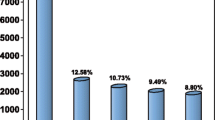Abstract
Objective
To evaluate the accuracy of ACCUFLOW an infusion rate monitor as compared to manual reading in pediatric surgical patients.
Methods
An observational study in 47 pediatric patients undergoing elective surgical procedures and needing an intravenous fluid with expected duration of infusion of at least one hour. The infusion rate was adjusted to the required flow rate with the help of the display on the ACCUFLOW. The flow rate as indicated by the ACCUFLOW display was checked every15 minutes till the end of one hour. A simultaneous record of manual readings was also made.
Results
A total of 470 observations were made over the one hour observation period. The infusion rate as observed on the LCD display of the ACCUFLOW compared well with manual reading. A Bland Altman analysis showed the bias between the readings with the two methods to be very small and that there is no significant difference between the methods over the drop rate of 61–74 drops/min. In addition an alarm was heard in 9 cases. The alarm was mainly because of no flow or excess flow (3 cases each). Other causes for the alarm included slow flow, faulty IV lines showing fluctuations in flow rate and drip chamber not placed properly (1 patient each).
Conclusion
ACCUFLOW is a low cost device that can be used to adjust and monitor the infusion flow rate. The alarm would alert the nursing staff when there is deviation from the preset rate of infusion. ACCUFLOW could thus be an attractive option for infusion rate monitoring in developing countries with limited healthcare resources and skewed patient nurse ratios. However applicability to infants and younger children and for longer infusions needs to be determined.
Similar content being viewed by others
References
Larsen GY, Parker HB, Cash J, O’Connell M, Grant MC. Standard Drug Concentrations and Smart-Pump Technology Reduce Continuous-Medication-Infusion Errors in Pediatric Patients. Pediatrics 2005; 116: e21–e25.
Han PY, Coombes ID, Green B. Factors predictive of intravenous fluid administration errors in Australian surgical care wards. Qual Saf Health Care 2005; 14: 179–184.
Okstein CJ. Patient Tampering with Electronic Intravenous Fluid Regulators. Pediatrics 1984; 73: 250–251.
Hadzic A, Vloka JD. Intravenous Infusion Sets (IV Set) In Anesthesia Practice: A Survey On Their Use And A Look Into The Future: Internet J Anes. 2000; 4(4). (http://www.ispub.com/ostia/index.php?xmlFilePath=journals/ijanp/vol4n2/ivset.xml)
Nair SG, Balachandran R. Perioperative fluid and electrolyte management in pediatric patients. Indian J Anaesth 2004; 48: 355–364.
Taxis K, Barber N. Causes of intravenous medication errors: an ethnographic study. Qual Saf Health Care 2003; 12: 343–348.
Author information
Authors and Affiliations
Corresponding author
Rights and permissions
About this article
Cite this article
Shroff, P., Patel, R.D., Dave, S. et al. Accuflow an infusion rate monitor: An evaluation in pediatric patients. Indian J Pediatr 74, 1099–1101 (2007). https://doi.org/10.1007/s12098-007-0205-9
Received:
Accepted:
Published:
Issue Date:
DOI: https://doi.org/10.1007/s12098-007-0205-9




